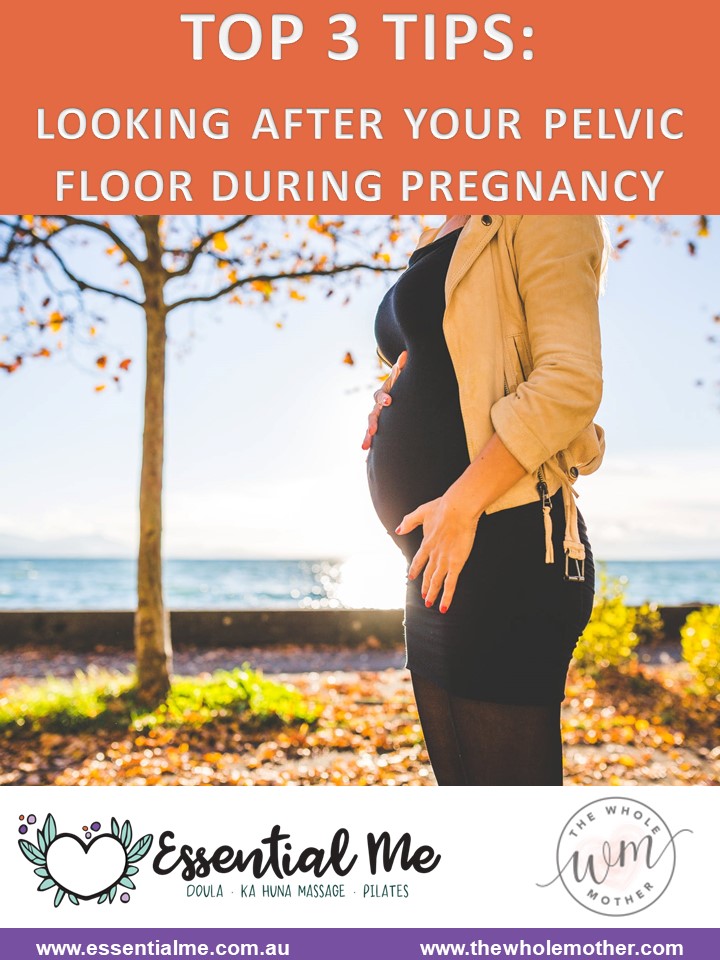TOP 3 TIPS: Looking After Your Pelvic Floor During Pregnancy
Blog post written by Anna Scammell
Since pregnancy is such a transformative time physically, it’s critical that every woman knows how to look after her pelvic floor. Women later in life commonly say to me “If I only I knew this when I was having my babies!” So now it is my mission to educate and empower women on how to look after their pelvic floor during pregnancy and postpartum to prevent unwanted issues.
The unwanted issues women commonly experience are prolapse and bladder leakage – with 50% of women experiencing a prolapse after having a baby and 1 in 3 experiencing incontinence (scarily high statistics I know!). BUT, the good news is that prolapse and incontinence can be prevented. If you’re not sure what a prolapse is, it is when a pelvic organ (bladder, bowel or uterus) descends into the vaginal canal giving you an uncomfortable heavy sensation or a lump/bulge when you wipe yourself. Prolapse and incontinence can be very distressing for women, so follow my tips below to avoid being a statistic!
Firstly though, I need you to know that women who have caesarian sections are not free from pelvic floor issues (sorry ladies!). The weight and pressure of the baby on your pelvic floor during pregnancy can be enough to cause pelvic floor weakness so it’s important for you to keep reading too!
My Top 3 Tips to Looking After Your Pelvic Floor During Pregnancy:
1. Do Your Pelvic floor Exercises Correctly
I can’t stress enough the importance of doing pelvic floor exercises regularly and correctly during pregnancy. The evidence shows that pelvic floor exercises can prevent bladder leakage and prolapse after childbirth – so they really do work!
The key to pelvic floor exercises is doing them correctly, so make sure you see a Women’s Health Physiotherapist during your pregnancy to check this. In the meantime you can download my FREE Pelvic Floor Guide here.
As important as it is to have strong pelvic floor muscles to optimise your postpartum recovery, you also need to ensure your muscles relax completely as well. During a vaginal birth, your pelvic floor muscles need to relax and then stretch to accommodate your baby’s head. As a result, learning how to relax your pelvic floor muscles using your breath is an important strategy in preparation for childbirth. An effective way to achieve this is regularly practising diaphragmatic breathing described here.
2. Exercise Safely During Pregnancy
The key to exercising during pregnancy is knowing how to do so safely, taking into consideration your pelvic floor. Pregnancy is not a time to continue exercising as intensely as you did previously. It is a time to move your body in ways that leave you feeling energised and strong, not depleted and fatigued.
High-impact exercise (involving running and jumping) and heavy weights are not safe for your pelvic floor regardless of how fit and strong you may be. Even if you are not symptomatic now, you may suffer prolapse or incontinence later if you continue this type of exercise during pregnancy and postpartum – especially if you have multiple pregnancies.
I recommend pregnant women do a combination of low-impact cardiovascular exercise, strength training, core exercise and stretching. Examples are brisk walking, swimming, aqua aerobics, pregnancy Pilates and yoga, light machine weights and resistance band exercises.
Find out more on safe exercise during pregnancy here.
3. Avoid Straining to Use Your Bowels
Constipation is a significant risk factor to developing pelvic floor weakness. This is because straining increases intra-abdominal pressure and bears down on the pelvic floor.
Some women force themselves to use their bowels daily or when they don’t feel a strong urge, so end up straining. What we don’t realise is that normal bowel motion frequency ranges from 3 times a day to 3 times a week. The key to this is the consistency of the stool – it must be soft and formed. If the stool is hard or pellet-like then you are likely to strain and this is a real problem.
Avoiding constipation and keeping your stool soft is also critical after childbirth, as your pelvic floor is healing and the stool needs to pass smoothly without any additional pressure on this area.
There are several strategies to avoid and treat constipation you can read here. A few of these include ensuring you are drinking at least 2L of fluid (ideally water) during your pregnancy and having a big glass of warm water upon waking. Diet is also really important for bowel health so ensure you are eating lots of vegetables and fruit, greens, healthy fats, slow cooked meals, and meat in moderation. Reduce your intake of white refined carbohydrates (bread, pasta, biscuits etc.), cheese and processed foods, which are drying and inflammatory for the bowel.
The way you sit on the loo is also an essential component to prevent straining as it improves the rectal angle making it easier for the stool to pass. First thing you need to do is get your hands on a foot stool (pardon the pun!). Sit with your feet on stool so your knees are higher than your hips. Keeping your back straight, lean forwards with your elbows resting on your knees. Then breathing into your belly making a “ssssssssssss” sound will relax your pelvic floor.
About Anna
Anna Scammell is a Masters-trained Women’s Health & Pelvic Floor Physiotherapist in Australia, and Founder of www.thewholemother.com. Anna offers online consults, combining her 10+ years of clinical experience, evidence based knowledge, and passion for health & wellbeing. She also sees clients out of Sevenways Health Centre in North Bondi. Anna’s mission is to educate, empower & inspire as many women as possible to be the best version of themself during their childbearing years.
Connect with Anna:
Email: anna@thewholemother.com
Website: www.thewholemother.com
Social: @the.whole.mother
References:
Hay-Smith J, Morkved S, Fairbrother K, Herbison G (2009) Pelvic floor muscle training for prevention and treatment of urinary and faecal incontinence in antenatal and postnatal women. Cochrane database of systematic reviews: 1-26.
Hilde and Bo (2015) The pelvic floor during pregnancy and childbirth, and the effect of pelvic floor muscle training on urinary incontinence – a literature review. Current Women’s Health Reviews 11:19-30.
Morkved S (2007) Pelvic floor muscle training during pregnancy and after delivery. Current Women's Health Reviews 3: 55-62.
About Essential Me
Hi, I'm Amanda. I support women and couples during their pregnancy, birth and postnatal journey as a Doula, Ka Huna massage therapist and Pilates instructor. I'm Based in Sydney and would love to help you. Please check out my Top 10 Tips for the best possible birth experience here. I'd love to meet you for an obligation free interview to see if you feel we're the right fit. Contact me here. Thanks, Amanda x



